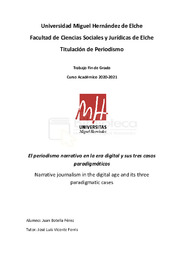Por favor, use este identificador para citar o enlazar este ítem:
https://hdl.handle.net/11000/27789Registro completo de metadatos
| Campo DC | Valor | Lengua/Idioma |
|---|---|---|
| dc.contributor.advisor | Vicente Ferris, José Luis | - |
| dc.contributor.author | Botella Pérez, Juan | - |
| dc.contributor.other | Departamentos de la UMH::Ciencias Sociales y Humanas | es_ES |
| dc.date.accessioned | 2022-10-06T11:05:48Z | - |
| dc.date.available | 2022-10-06T11:05:48Z | - |
| dc.date.created | 2022-06-07 | - |
| dc.identifier.uri | https://hdl.handle.net/11000/27789 | - |
| dc.description.abstract | El propósito de la siguiente investigación es conocer el estado actual de uno de los géneros más destacables y reconocibles del ámbito periodístico: el periodismo narrativo o literario. Al tratarse de un género con largo recorrido pero de profunda dificultad y trabajoso, ha ido ocupando cada vez menos espacio en el panorama actual de los medios de comunicación. Su incuestionable popularidad en el pasado ha ido desapareciendo en una realidad donde cada vez existe menos tiempo para una lectura pausada. Era preciso pues, investigar los orígenes de este en el pasado siglo y sus principales características además de los medios y escritores y escritoras que más hubiesen contribuido. Además, era preciso analizar y tener en cuenta la evolución del periodismo gracias a la introducción de nuevas tecnologías y formatos que han ido ganando popularidad en los últimos años. Para conseguir conocer esto, se han seleccionado e investigado profundamente los trabajos de tres medios de comunicación que principalmente apuestan por este género periodístico y que además utilizan las posibilidades que la tecnología ofrece a los periodistas en estos últimos años.Estos tres medios han sido elegidos por su prestigio, innovación o largo recorrido, convirtiéndose en aquellos paradigmas del periodismo narrativo. Una vez seleccionados los tres medios, además de estudiar sus orígenes, sus miembros y objetivos, se han recopilado las distintas características y técnicas narrativas más utilizadas en sus trabajos. Conociendo las principales características que estos medios utilizan para crear sus piezas periodísticas, es posible analizar cómo la narrativa ha evolucionado con el paso de los años y cómo se ha ido adaptando a los tiempos cambiantes llenos de fake news y donde el “última hora” está más cotizado que nunca. Por último, era interesante conocer el estado de dichos medios en el panorama mediático, su mercado de clientes y su crecimiento como negocio para determinar si existe interés por este producto. | es_ES |
| dc.description.abstract | The purpose of the following investigation is to know the current state of one of the most remarkable and recognizable genres in the journalistic field: narrative or literary journalism. As it is a genre with a long history but one of profound difficulty and laboriousness, it has been occupying less and less space in the current panorama of the media. Its unquestionable popularity in the past has been disappearing in a reality where there is less and less time for leisurely reading. It was therefore necessary to investigate its origins in the last century and its main characteristics, as well as the media and writers who had contributed the most. In addition, it was necessary to analyze and take into account the evolution of journalism thanks to the introduction of new technologies and formats that have been gaining popularity in recent years. To get to know this, the works of three media outlets that are mainly committed to this journalistic genre and that also use the possibilities that technology offers journalists in recent years have been selected and thoroughly investigated. These three media outlets have been chosen by its prestige, innovation or long journey, becoming those paradigms of narrative journalism. Once the three media have been selected, in addition to studying their origins, their members and objectives, the different characteristics and narrative techniques most used in their works have been compiled. Knowing the main characteristics that these media use to create their journalistic pieces, it is possible to analyze how the narrative has evolved over the years and how it has been adapting to changing times full of fake news and where the "last hour" is more sought after than ever. Lastly, it was interesting to know the status of these media outlets in the media landscape, their customer market and their growth as a business to determine if there is interest in what their journalists write. | es_ES |
| dc.format | application/pdf | es_ES |
| dc.format.extent | 51 | es_ES |
| dc.language.iso | spa | es_ES |
| dc.publisher | Universidad Miguel Hernández de Elche | es_ES |
| dc.rights | info:eu-repo/semantics/openAccess | es_ES |
| dc.rights | Attribution-NonCommercial-NoDerivatives 4.0 Internacional | * |
| dc.rights.uri | http://creativecommons.org/licenses/by-nc-nd/4.0/ | * |
| dc.subject | narrativa | es_ES |
| dc.subject | literatura | es_ES |
| dc.subject | periodismo | es_ES |
| dc.subject | tecnología | es_ES |
| dc.subject | evolución | es_ES |
| dc.subject | narrative | es_ES |
| dc.subject | literature | es_ES |
| dc.subject | journalism | es_ES |
| dc.subject | technology | es_ES |
| dc.subject | evolution | es_ES |
| dc.subject.other | CDU::0 - Generalidades.::070 - Periódicos. Prensa. Periodismo. Ciencias de la información | es_ES |
| dc.title | El periodismo narrativo en la era digital y sus tres casos paradigmáticos | es_ES |
| dc.title.alternative | Narrative journalism in the digital age and its three paradigmatic cases | es_ES |
| dc.type | info:eu-repo/semantics/bachelorThesis | es_ES |

Ver/Abrir:
TFG-Botella Pérez, Juan.pdf
16,24 MB
Adobe PDF
Compartir:
 La licencia se describe como: Atribución-NonComercial-NoDerivada 4.0 Internacional.
La licencia se describe como: Atribución-NonComercial-NoDerivada 4.0 Internacional.
.png)